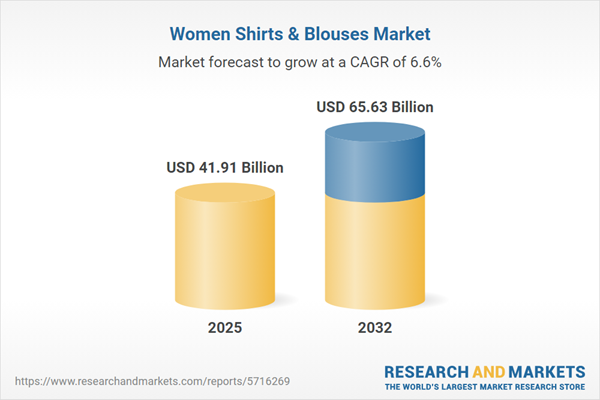Speak directly to the analyst to clarify any post sales queries you may have.
The women’s shirts and blouses market is evolving rapidly as buyer expectations, compliance pressures, and competitive intensity reshape commercial priorities. Senior leaders in this industry require precise, actionable business intelligence to inform strategy and build long-term operational resilience amid these dynamic shifts.
Market Snapshot: Women’s Shirts and Blouses Market Size and Growth
In 2024, the global women’s shirts and blouses market is valued at USD 39.25 billion and is projected to reach USD 41.91 billion by 2025, representing a compound annual growth rate (CAGR) of 6.63% through 2032. Growth is fueled by constant product innovation, advanced utilization of digital commerce channels, and heightened focus on sustainable manufacturing. As digital transformation accelerates and sustainability becomes a central concern, organizations face a landscape where managing complex stakeholder interactions and compliance requirements is essential for securing a competitive edge and harnessing new growth opportunities.
Scope & Segmentation: Actionable B2B Insights on the Women’s Shirts and Blouses Market
This report provides senior executives with a structured framework for segment analysis, enabling the identification of growth avenues and informed strategic decisions across the global women’s shirts and blouses sector.
- Distribution Channels: Coverage includes traditional retail, fast-growing e-commerce platforms, global online marketplaces, and emerging social commerce models, each critical for crafting omnichannel strategies that engage both established and new markets.
- Price Ranges: The segmentation of luxury, premium, and mass-market offerings helps businesses refine regional positioning and address varying customer segments.
- Style Categories: Investigation into casual, formal, and culturally influenced designs supports optimal product assortment across workwear, leisure, and event-driven collections.
- Materials: Analysis includes organic cotton, combed cotton, recycled polyester, conventional polyester, blended textiles, and silk, with an emphasis on sustainable sourcing and responsible supply chain management.
- End Uses: Exploration of usage scenarios, spanning daily wear to office attire and event-specific designs, prepares planners for evolving customer routines and preferences.
- Age Groups: Segmentation insights address purchasing drivers and trends among diverse age brackets including teens, young adults, adults, and seniors, facilitating improved targeting and engagement.
- Sizes: Detailed approaches for petite, regular, and plus sizing encourage inclusive product ranges and reflect broader market representation.
- Regions: Portfolio coverage extends across the Americas, Europe, Middle East, Africa, and Asia-Pacific, outlining unique buyer behaviors, compliance environments, and commercial trends specific to each region.
- Key Companies: Executive profiles and strategy reviews of key market players including Industria de Diseño Textil, S.A., H & M Hennes & Mauritz AB, Fast Retailing Co., Ltd., Gap Inc., LVMH Moët Hennessy Louis Vuitton SE, Kering SA, PVH Corp., Ralph Lauren Corporation, Marks & Spencer Group plc, and Next plc, with analysis of market differentiation and business model evolution.
Key Takeaways for Strategic Decision-Makers
- Balanced product portfolios spanning casual and formal categories broaden brand appeal and support adaptation to regional preferences.
- Integration of advanced omnichannel tools, such as virtual try-on and in-store customization, deepens consumer relationships and enhances loyalty as retail channels diversify.
- Commitment to transparent, ethical sourcing and sustainability measures aligns with rising regulatory scrutiny and partner expectations in both mature and emerging markets.
- Data-driven marketing and inventory strategies, fine-tuned to regional variations, drive stronger local market penetration and brand resilience.
- Deployment of digital fit tools and targeted social commerce campaigns increases engagement and supports responsive adjustments to market evolution.
Tariff Impact: Effects on Sourcing and Supply Chains
Recent U.S. tariff adjustments have prompted businesses to reassess global sourcing and diversify supply chains, spurring greater interest in domestic and nearshore manufacturing partners. The development of adaptive pricing strategies and scenario planning measures has enabled organizations to bolster resilience and maintain competitiveness amid shifting trade environments.
Methodology & Data Sources
This research applies a robust, multi-stage process including executive interviews, expert contributions from retail and supply chain specialists, and comprehensive examination of financial records, trade flows, and regulatory documentation. Multiple validation steps and peer benchmarking ensure reliability and accuracy in the delivered insights.
Why This Report Matters for B2B Leaders in the Women’s Shirts and Blouses Market
- Enables better decisions in supply chain management, compliance, and sustainability by providing targeted market intelligence relevant to volatile and growth-focused regions.
- Offers advanced segmentation and competitor analysis to improve resource allocation and elevate risk management practices.
- Empowers senior leaders with clear, actionable insights as the market adapts to rapid regulatory and buyer-driven changes.
Conclusion
This report delivers essential guidance for B2B leaders aiming to develop proactive strategies, strengthen operational resilience, and seize new opportunities in an evolving global women’s shirts and blouses marketplace.
Additional Product Information:
- Purchase of this report includes 1 year online access with quarterly updates.
- This report can be updated on request. Please contact our Customer Experience team using the Ask a Question widget on our website.
Table of Contents
3. Executive Summary
4. Market Overview
7. Cumulative Impact of Artificial Intelligence 2025
Companies Mentioned
The companies profiled in this Women's Shirts & Blouses market report include:- Industria de Diseño Textil, S.A.
- H & M Hennes & Mauritz AB
- Fast Retailing Co., Ltd.
- Gap Inc.
- LVMH Moët Hennessy Louis Vuitton SE
- Kering SA
- PVH Corp.
- Ralph Lauren Corporation
- Marks & Spencer Group plc
- Next plc
Table Information
| Report Attribute | Details |
|---|---|
| No. of Pages | 192 |
| Published | October 2025 |
| Forecast Period | 2025 - 2032 |
| Estimated Market Value ( USD | $ 41.91 Billion |
| Forecasted Market Value ( USD | $ 65.63 Billion |
| Compound Annual Growth Rate | 6.6% |
| Regions Covered | Global |
| No. of Companies Mentioned | 11 |









